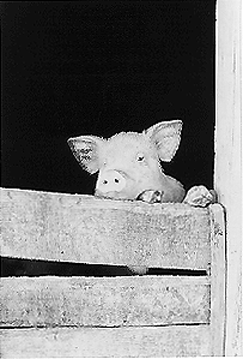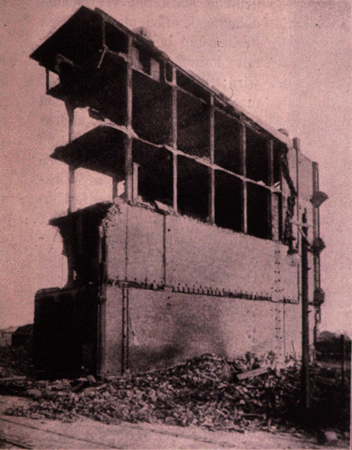







 The concepts of element strength and system stability are learned at an early age. They often appear in children's stories that have been repeated for decades. One favorite in North America is the story of the "Three Little Pigs." Each pig desired to build a house to protect itself from the Big, Bad Wolf. One pig built a house of straw while another built a house of sticks and twigs. The third pig erected a house of brick. The story follows that the big, bad wolf came to the homes of the three pigs. He drew a huge breath and huffed and puffed until he blew the first house down. He chased the pig into the second house where he repeated his imitation of a typhoon. This house was also blown over and the pigs fled into the brick house. In front of the brick house the wolf hyperventilated. His grandest attempts to blow over this ediface failed and so he did not have pork for dinner. The story teaches children that a brick building is the strongest and most stable becuase it is the only one which could resist the huffing and puffing. The straw and stick buildings were blown away in the wind and only within the brick structure do the three pigs find their security.
The concepts of element strength and system stability are learned at an early age. They often appear in children's stories that have been repeated for decades. One favorite in North America is the story of the "Three Little Pigs." Each pig desired to build a house to protect itself from the Big, Bad Wolf. One pig built a house of straw while another built a house of sticks and twigs. The third pig erected a house of brick. The story follows that the big, bad wolf came to the homes of the three pigs. He drew a huge breath and huffed and puffed until he blew the first house down. He chased the pig into the second house where he repeated his imitation of a typhoon. This house was also blown over and the pigs fled into the brick house. In front of the brick house the wolf hyperventilated. His grandest attempts to blow over this ediface failed and so he did not have pork for dinner. The story teaches children that a brick building is the strongest and most stable becuase it is the only one which could resist the huffing and puffing. The straw and stick buildings were blown away in the wind and only within the brick structure do the three pigs find their security.
This lesson is correct if the load that is of greatest concern is a tornado, typhoon, hurricane or similar lateral load. However, the brick house would have been the worst structure to live in if it was built in an earthquake zone. In fact, an unreinforced masonry building is much more life threatening in an earthquake when compared to a straw hut. Then again, another response would be appropriate if the house was in a region where winds were not a real problem, but extreme temperature variations were critical. The same would be true if mobility was the most significant issue. Each of these are specific loading conditions that could lead to structural failure. It is critical that the appropriate loads and loading combinations are considered for each and every structure depending on use and location. Every one is different!
"Humpy Dumpty" is another children's tale with a structural lesson. He was a good egg who sat on a wall for quite a while. One day he lost his balance and fell to the ground where all of the king's men could not put Humpty back together again. The egg shell is a wonderfully efficient, naturally occuring thin structure that is extremly strong under evenly distributed loading conditions. One type of load which a thin shell cannot resist is a sharp point load. Thus, when Humpty fell to the ground he loaded his wonderful structure in a way that caused a strength and system failure.

Building Codes are often considered to be the bane of architectural designers. However, they have been a part of the profession for thousands of years. The illustration above is a part of the Code of Hammurabi that was written about 2200BC. The Code can be translated as:
If a builder builds a house for a man and does not make its construction firm and the house collapses and causes the death of the owner of the house - that builder shall be put to death.If it causes the death of a son of the owner - a son of that builder shall be put to death .
If it causes the death of a slave of the owner - the builder shall give the owner a slave of equal value.
If it destroys property - the builder shall restore whatever it destroyed and because the builder did not make the house firm, shall rebuild the house which collapsed at his own expense.
If a builder builds a house and does not make its construction meet the requirements and a wall falls in - that builder shall strengthen the wall at his own expense.
Each and every one of us is a structural designer in their own way. The act of walking down a set of stairs or pushing a wheelchair forward or swimming across a pool requires an understanding of gravity, the flow of forces and how to work with them.
 Petroski notes: "The Concept of Failure is central to understanding engineering, it has as its first and foremost objective the obviation of failure. Design, even structural design, is a human endeavor and thus it is subject to error. Due to this, some designs are destined to fail. This can lead to a loss of life which in itself is tragic, but a deeper unforgivable tragedy exists when the lessons of the failure are understood and allowed to occur again."
Petroski notes: "The Concept of Failure is central to understanding engineering, it has as its first and foremost objective the obviation of failure. Design, even structural design, is a human endeavor and thus it is subject to error. Due to this, some designs are destined to fail. This can lead to a loss of life which in itself is tragic, but a deeper unforgivable tragedy exists when the lessons of the failure are understood and allowed to occur again."
Failure can also be illustrated with the following exercise. Take ten small paper clips. Twist each one back and forth and count the number of turns that it takes for each paper clip to fail. Note the variance in what seems to be exactly the same material for each one. What role does statistics play in structural design?
Homework Problems